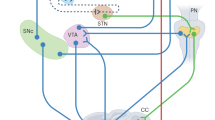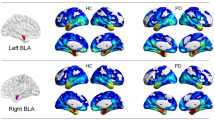Abstract
The amygdala undergoes severe pathological changes during the course of Parkinson's disease (PD). Lewy bodies and Lewy neurites are distributed in a specific manner throughout the nuclear complex. The lesional pattern displays only minor interindividual variation. The most prominent changes occur in the accessory cortical and central nuclei. The cortical, accessory basal and granular nuclei show less severe alterations, while the basal and lateral nuclei, as well as the intercalated cell masses, generally remain uninvolved. The amygdala receives a broad range of afferents, allowing integration of exteroceptive information with interoceptive data. It generates major projections to the isocortex (the prefrontal cortex in particular), limbic system (hippocampus and entorhinal region) and centers regulating endocrine and autonomic functions. The specific lesional pattern seen in PD destroys part of the nuclear gray matter and its connections and, thus, may likely contribute to the development of behavioral changes and autonomic dysfunction.
Similar content being viewed by others
References
Agid Y, Ruberg M, Dubois B, Pillon B, Cusimano G, Raisman R, Cash R, Lhermitte F, Javoy-Agid F (1986) Parkinson's disease and dementia. Clin Neuropharmacol 9 [Suppl 2]: 22–36
Alheid GF, Heimer L, Switzer RC (1990) Basal ganglia. In: Paxinos G (ed) The human nervous system. Academic Press, New York, pp 483–582
Amaral DG, Price JL, Pitkänen A, Carmichael ST (1992) Anatomical organization of the primate amygdaloid complex. In: Aggleton JP (ed) The amygdala: neurobiological aspects of emotion, memory, and mental dysfunction. Wiley-Liss, New York, pp 1–66
Ansari KA, Johnson A (1975) Olfactory function in patients with Parkinson's disease. J Chronic Dis 28: 493–497
Babinski R, Calabrese P, Durwen HF, Markowitsch HJ, Brechtelsbauer D, Heuser L, Gehlen W (1993) The possible contribution of the amygdala to memory. Behav Neurol 6: 167–170
Bancher C, Lassmann H, Budka H, Jellinger K (1989) An antigenic profile of Lewy bodies: immunocytochemical indication for protein phosphorylation and ubiquitination. J Neuropathol Exp Neurol 48:81–93
Bancher C, Braak H, Fischer P, Jellinger K (1993) Neuropathological staging of Alzheimer lesions and intellectual status in Alzheimer's and Parkinson's disease. Neurosci Lett 162:179–182
Braak E, Braak H, Mandelkow EM (1994) A sequence of cytoskeleton changes related to the formation of neurofibrillary tangles and neutropil threads. Acta Neuropathol 87: 554–567
Braak H (1980) Architectonics of the human telencephalic cortex. Springer, Berlin Heidelberg New York, pp 1–147
Braak H, Braak E (1983) Neuronal types in the basolateral amygdaloid nuclei of man. Brain Res Bull 11: 349–365
Braak H, Braak E (1990) Cognitive impairment in Parkinson's disease: amyloid plaques, neurofibrillary tangles, and neuropil threads in the cerebral cortex. J Neural Transm [P-D Sect] 2: 45–57
Braak H, Braak E (1991) Neuropathological stageing of Alzheimer-related changes. Acta Neuropathol 82: 239–259
Braak H, Braak E (1991) Demonstration of amyloid deposits and neurofibrillary changes in whole brain sections. Brain Pathol 1: 213–216
Braak H, Braak E (1993) Anatomy of the human basal ganglia. In: Szelenyi I (ed) Inhibitors of monoamine oxidase B. Birkhäuser, Basel, pp 3–23
Braak H, Braak E (1994) Pathology of Alzheimer's disease. In: Calne DB (ed) Neurodegenerative diseases. Saunders, Philadelphia, pp 585–613
Brady DR, Mufson EJ (1990) Amygdaloid pathology in Alzheimer's disease: qualitative and quantitative analysis. Dementia 1: 5–17
Campbell SK, Switzer RC, Martin TL (1987) Alzheimer's plaques and tangels: a controlled and enhanced silver-staining method. Soc Neurosci Abstr 13: 678
Dickson DW, Wertkin A, Kress Y, Ksiezak-Reding H, Yen SH (1990) Ubiquitin immunoreactive structures in normal human brain. Distribution and developmental aspects. Lab Invest 63: 87–99
Dickson DW, Ruan D, Crystal H, Mark MH, Davies P, Kress Y, Yen SH (1991) Hippocampal degeneration differentiates diffuse Lewy body disease (DLBD) from Alzheimer's disease: light and electron microscopic immunocytochemistry of CA2-3 neurites specific to DLBD. Neurology 41: 1402–1409
Dickson DW, Schmidt ML, Lee VMY, Meng-Liang Zhao, Yen SH, Trojanowski JQ (1994) Immunoreactivity profile of hippocampal CA2/3 neurites in diffuse lewy body disease. Acta Neuropathol 87: 269–276
Doty RL, Deems DA, Stellar S (1988) Olfactory dysfunction in parkinsonism: A general deficit unrelated to neurologic signs, disease stage, or disease duration. Neurology 38: 1237–1244
Fearnley J, Lees A (1991) Ageing and Parkinson's disease: substantia nigra regional selectivity. Brain 114: 2283–2301
Fearnley J, lees A (1994) Pathology of Parkinson's disease. In: Calne DB (ed) Neurodegenerative diseases. Saunders, Philadelphia, pp 545–554
Forno LS (1986) The Lewy body in Parkinson's disease. Adv Neurol 45: 35–43
Gallagher M, Holland PC (1992) Understanding the function of the central nucleus: is simple conditioning enough? In: Aggleton JP (ed) The amygdala: neurobiological aspects of emotion, memory, and mental dysfunction. Wiley-Liss, New York, pp 307–321
Gallyas F (1971) Silver staining of Alzheimer's neurofibrillary changes by means of physical development. Acta Morphol Acad Sci Hung 19: 1–8
Gibb WRG (1991) Neuropathology of the substantia nigra. Eur Neurol 31 [Suppl 1]: 48–59
Gibb WRG, Lees AJ (1988) The relevance of the Lewy body to the pathogenesis of idiopathic Parkinson's disease. J Neurol Neurosurg Psychiatry 51: 745–752
Gibb WRG, Lees AJ (1989) The significance of the Lewy body in the diagnosis of idiopathic Parkinson's disease. Neuropathol Appl Neurobiol 15: 27–44
Gibb WRG, Lees AJ (1991) Anatomy, pigmentation, ventral and dorsal subpopulations of the substantia nigra, and differential cell death in Parkinson's disease. J Neurol Neurosurg Psychiatry 54: 388–396
Hyman BT, Van Hoesen GW, Damasio AR (1990) Memoryrelated neural systems in Alzheimer's disease: an anatomic study. Neurology 40: 1721–1730
Iqbal K, Braak H, Braak E, Grundke-Iqbal I (1993) Silver labeling of Alzheimer neurofibrillary changes and brain β-amyloid. J Histotechnol 16: 335–342
Jellinger K (1989) Pathology of Parkinson's disease. In: Calne DB (ed) Handbook of experimental pharmacology, vol 88. Drugs for the treatment of Parkinson's disease. Springer, Berlin Heidelberg New York, pp 47–112
Jellinger K (1991) Pathology of Parkinson's disease. Changes other than nigrostriatal pathway. Mol Chem Neuropathol 14: 153–197
Jellinger K, Braak H, Braak E, Fischer P (1991) Alzheimer lesions in the entorhinal region and isocortex in Parkinson's and Alzheimer's diseases. Ann N Y Acad Sci 640: 203–209
Kemper TL (1983) Organization of the neuropathology of the amygdala in Alzheimer's disease. In: Report B (ed) Biological aspects of Alzheimer's disease. Banbury Report, vol 15. Cold Spring Harbor Laboratory Press, Cold Spring Harbor, pp 31–35
Kromer-Vogt LJ, Hyman BT, van Hoesen GW, Damasio AR (1990) Pathological alterations in the amygdala in Alzheimer's disease. Neuroscience 37: 377–385
Kuzuhara S, Mori H, Izumiyama N, Yoshimura M, Ihara Y (1988) Lewy bodies are ubiquitinated. A light and electron microscopic study. Acta Neuropathol (Berl) 75: 345–353
Leigh PN, Probst A, Dale GE, Power DP, Brion JP, Dodson A, Anderton BH (1989) New aspects of the pathology of neurodegenerative disorders as revealed by ubiquitin antibodies. Acta Neuropathol 79: 61–72
Lewy FH (1912) Paralysis agitans. I. Pathologische Anatomie. In: Lewandowski M (ed) Handbuch der Neurologie, vol 3. Springer, Berlin, pp 920–933
Lewy FH (1923) Die Lehre vom Tonus und der Bewegung. Springer, Berlin.
Lowe J (1994) Lewy bodies. In: Calne DB (ed) Neurodegenerative diseases. Saunders, Philadelphia, pp 51–69
Mayeux R, Stem Y, Rosen J, Leventhal J (1981) Depression, intellectual impairment and Parkinson's disease. Neurology 31: 645–650
Perry G (1994) Is a Lewy body always a Lewy body? Behav Neurol 7: 27
Pollanen MS, Dickson DW, Bergeron C (1993) Pathology and biology of the Lewy body. J Neuropathol Exp Neurol 52: 183–191
Price JL (1990) Olfactory system. In: Paxinos G (ed) The human nervous system. Academic Press, New York, pp 979–998
Price JL, Russchen FT, Amaral DG (1987) The limbic region. II. The amygdaloid complex. In: Björklund A, Hökfelt T, Swanson SW (eds) Handbook of chemical neuroanatomy, vol 5. Elsevier, Amsterdam, pp 279–388
Quinn NP, Rossor MN, Marsden CD (1987) Olfactory threshold in Parkinson's disease. J Neurol Neurosurg Psychiatry 50: 88–89
Rajput AH (1994) Clinical features and natural history of Parkinson's disease (special consideration of aging). In: Calne DB (ed) Neurodegenerative diseases. Saunders, Philadelphia, pp 555–571
Saper CB (1990) Hypothalamus. In: Paxinos G (ed) The human nervous system. Academic Press, New York, pp 389–413
Sarter M, Markowitsch HJ (1985) The amygdala's role in human mnemonic processing. Cortex 21: 7–24
Sims KS, Williams RS (1990) The human amygdaloid complex: a cytologic and histochemical atlas using Nissl, myelin, acetylcholinesterase and nicotinamide adenine dinucleotide phosphate diaphorase staining. Neuroscience 36: 449–472
Unger JW, Lapham LW, McNeill TH, Eskin A, Hamill RW (1991) The amygdala in Alzheimer's disease: neuropathology and Alz 50 immunoreactivity. Neurobiol Aging 12: 389–399
Van Domburg PHMF, ten Donkelaar HJ (eds) (1991) The human substantia nigra and ventral tegmental area. Springer, Berlin Heidelberg New York, pp 1–132
Ward CD, Hess WA, Calne DB (1983) Olfactory impairment in Parkinson's disease. Neurology 33: 943–946
Author information
Authors and Affiliations
Rights and permissions
About this article
Cite this article
Braak, H., Braak, E., Yilmazer, D. et al. Amygdala pathology in Parkinson's disease. Acta Neuropathol 88, 493–500 (1994). https://doi.org/10.1007/BF00296485
Received:
Accepted:
Issue Date:
DOI: https://doi.org/10.1007/BF00296485




